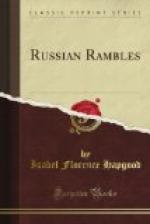The bones of Prince Alexander were brought to St. Petersburg, from their resting-place in the Vladimir Government, in 1724, Peter the Great occupying his favorite post as pilot and steersman in the saint’s state barge, and they now repose in the monastery cathedral, under a canopy, and in a tomb of silver, 3600 pounds in weight, given by Peter’s daughter, the devout Empress Elizabeth. In the cemetery surrounding the cathedral, under the fragrant firs and birches, with the blue Neva rippling far below, lie many of the men who have contributed to the advancement of their country in literature, art, and science, during the last two centuries.
Of all the historical memories connected with this monastery none is more curious than that relating to the second funeral of Peter III. He had been buried by his wife, in 1762, with much simplicity, in one of the many churches of the Lavra, which contains the family tombs and monuments not only of members of the imperial family, but of the noble families most illustrious in the eighteenth century. When Paul I. came to the throne, in 1796, his first care was to give his long-deceased father a more fitting burial. The body was exhumed. Surrounded by his court, Pavel Petrovitch took the imperial crown from the altar, placed it on his own head, then laid it reverently on his father’s coffin. When Peter III. was transferred immediately afterward, with magnificent ceremonial, to the Winter Palace, there to lie in state by the side of his wife, Katherine II., and to accompany her to his proper resting-place among the sovereigns of Russia, in the cathedral of the Peter-Paul fortress, Count Alexei Grigorevitch Orloff was appointed, with fine irony, to carry the crown before his former master, whom he had betrayed, and in the necessity for whose first funeral he had played the part of Fate. It was with considerable difficulty that he was hunted up, while Emperor and pageant waited, in the obscure corner where he was sobbing and weeping; and with still greater difficulty was he finally persuaded to perform the task assigned to him in the procession.
Outside the vast monastery, which, like most Russian monasteries, resembles a fortress, though, unlike most of them, it has never served as such, the scene is almost rural. Pigeons, those symbols of the Holy Ghost, inviolable in Russia, attack with impunity the grain bags in the acres of storehouses opposite, pick holes, and eat their fill undisturbed.
From this spot to the slight curve in the Prospekt, at the Znamenskaya Square, a distance of about a mile, where the Moscow railway station is situated, and where the train of steam tram-cars is superseded by less terrifying horse-cars, the whole aspect of the avenue is that of a provincial town, in the character of the people and the buildings, even to the favorite crushed strawberry and azure washes, and green iron roofs on the countrified shops. Here and there, not very far away, a log-house may even be espied.




